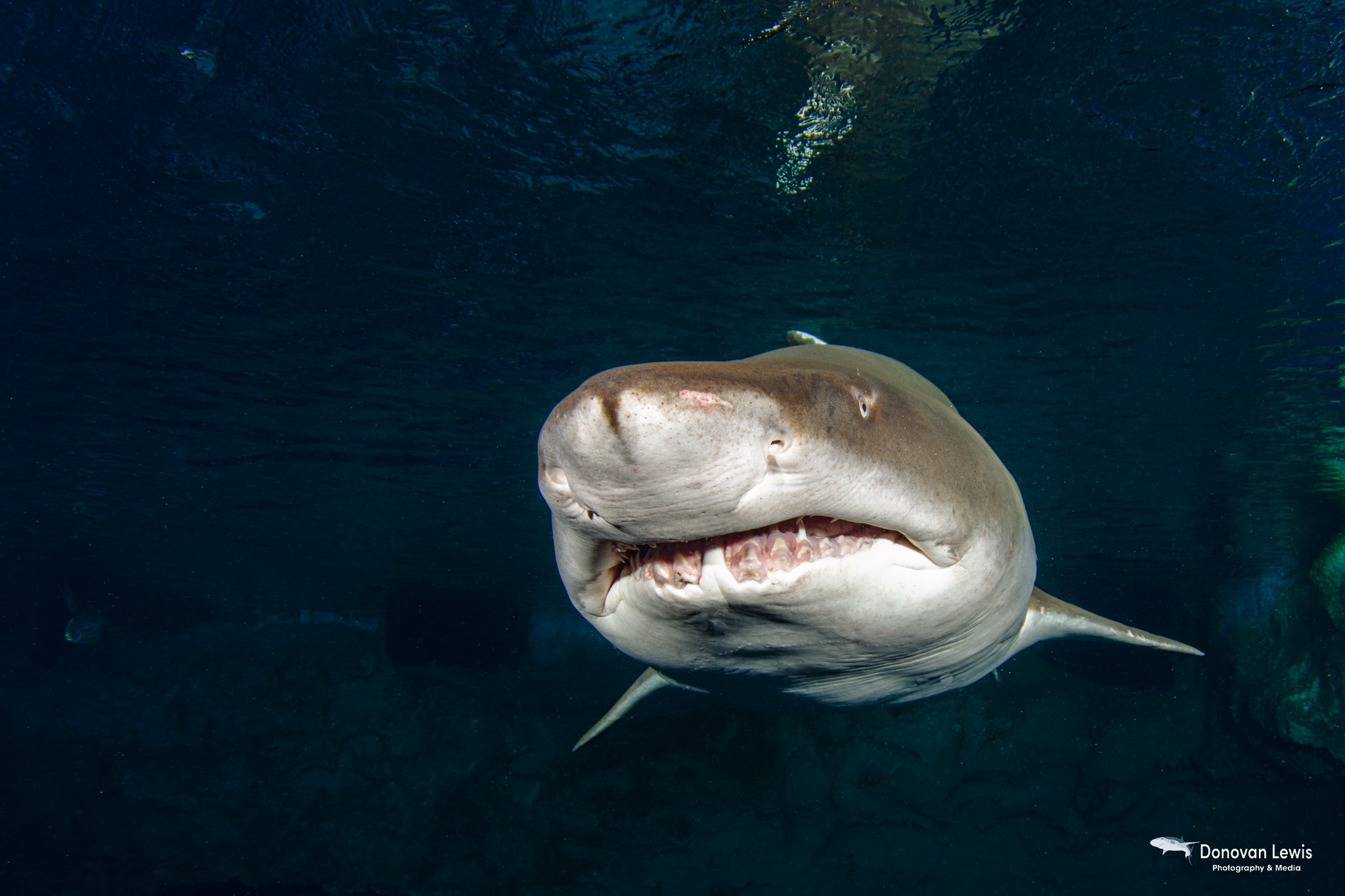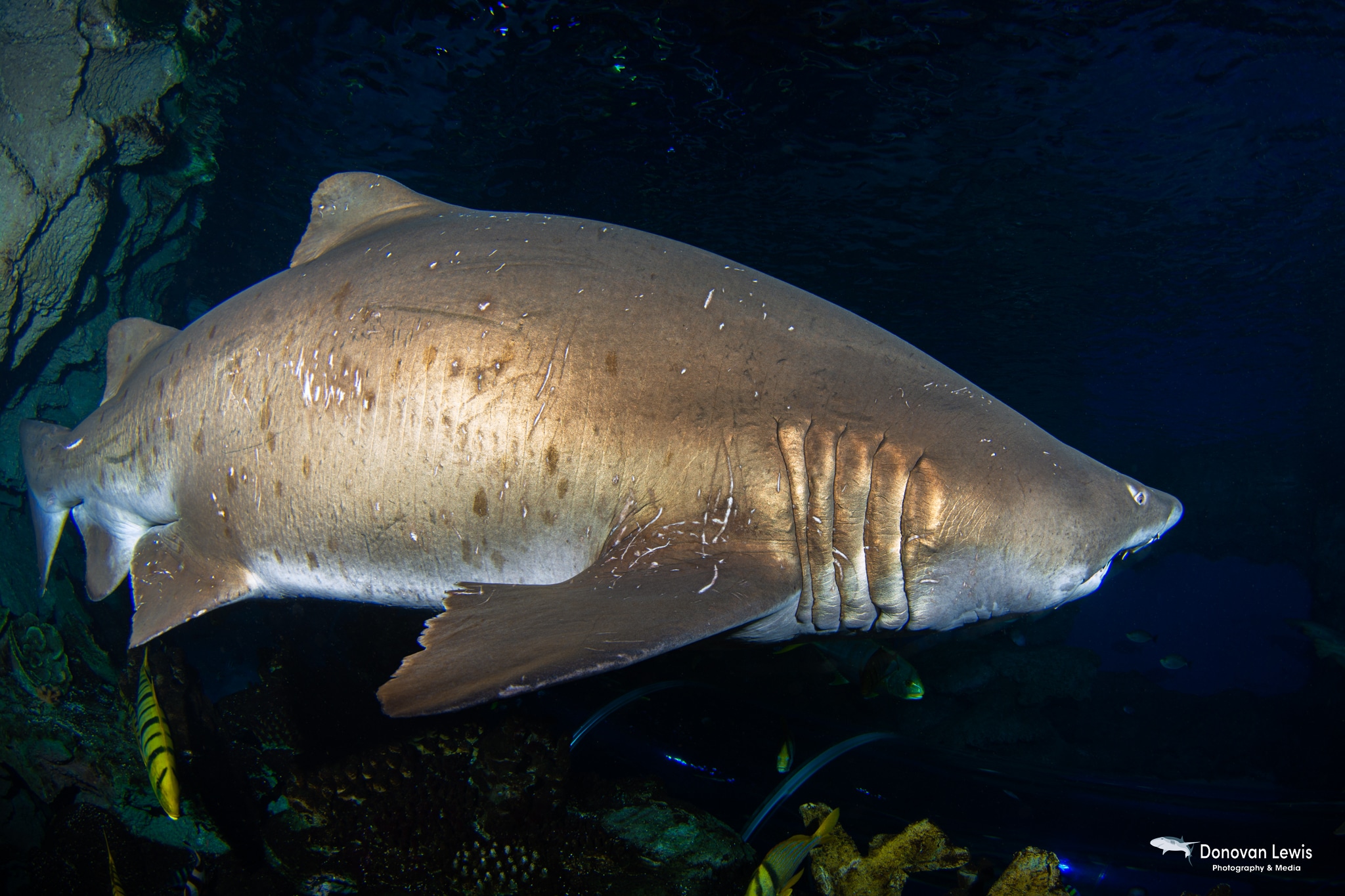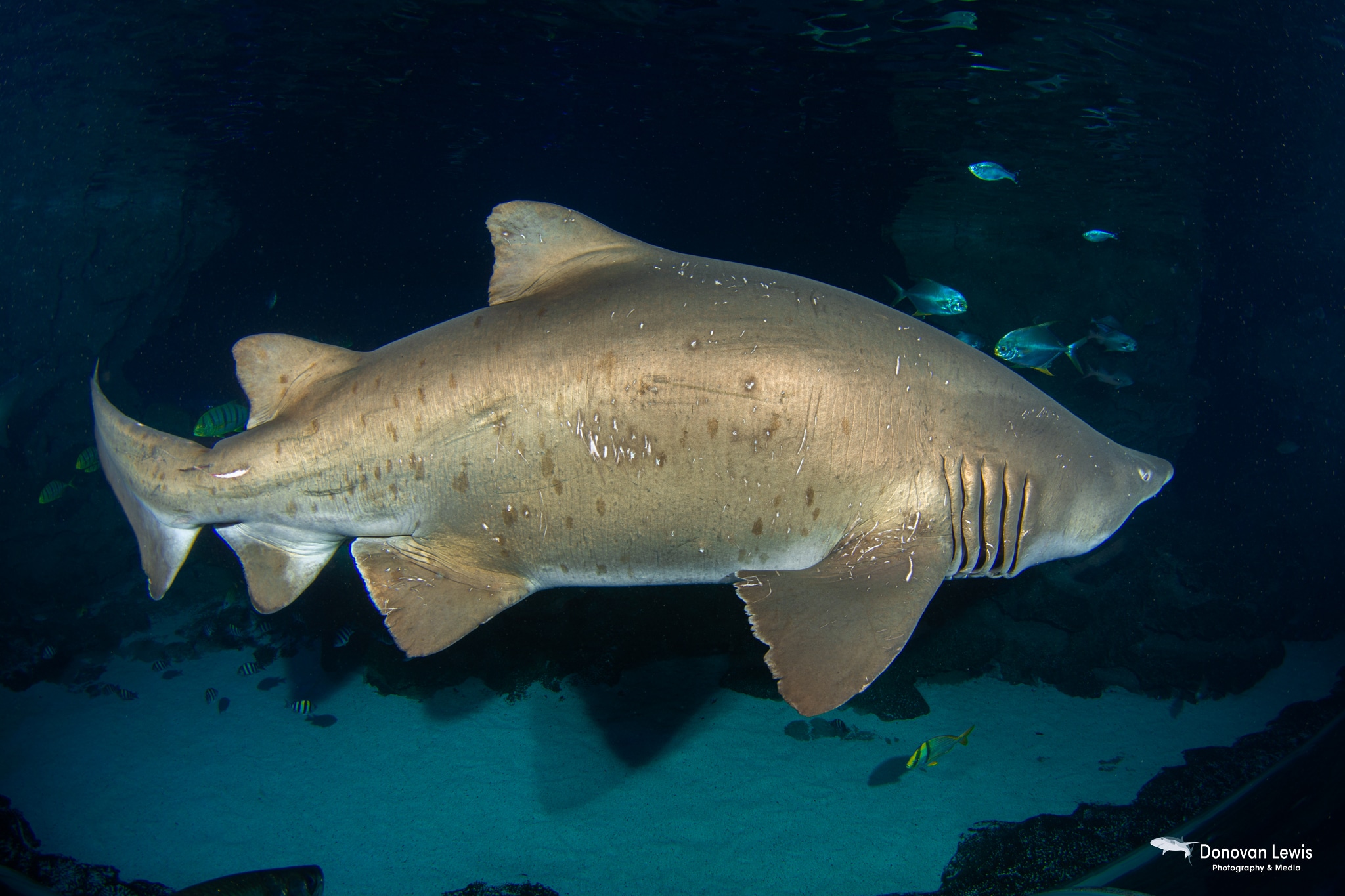Marine Life & Conservation Blogs
Love is in the air at Blue Planet Aquarium

Every year between the end of January and mid-May when the water is at its coldest and begins to warm up for summer, Blue Planet Aquarium has its annual Sand Tiger Shark mating season. During this time of year, the dynamics in the tank completely change, from what are usually slow moving and often sleeping sharks turn into fast moving Sharks who have only one thing on their mind.
In previous blogs I’ve mentioned how relaxed the Sharks are, but during this time the Sharks are at the complete opposite end of the scale, sometimes seeming oblivious to our presence, they can tend to almost “play chicken” with the divers, swimming very close, which can sometimes make us jump a little. Even with this change in behaviour however the animals are still quite easy to work with and we always respect their boundaries and rules as it is their home at the end of the day.
The changes in behaviour start around mid to late January with a huge reduction in appetite for all our Sand Tigers, they will go down to eating almost nothing throughout the mating season, we even have them spit food out after grabbing it.
The next sign usually starts with the males moving a lot faster and will duck and dive between the different levels in the tank, it can be chaotic one day and then almost nothing the next, on the opposite end the females will slow right down and tend to spend a large amount of time either on or near the bottom.
It is like this for about a month before the action really starts, the next sign is what’s known as “tracking”, this is where you will have the female of interest at the front with the alpha male close behind her, with the subordinate males trailing behind him. This happens for a couple of weeks until around March where the height of mating season starts, after a month or so of tracking and a little bit of bickering there will be an “alpha” male who will control mating in the tank. Alpha males will then protect the area where females are congregating and will then force less dominant males out by snapping their jaws at them, snapping tends to be enough to force males out, however seeing bite marks on the males is not uncommon.
When Sharks mate the males tend to bite the females around their pectoral fins or on their sides, this is done to help hold themselves in place during mating and to make it easier to mate by slowing the female down, females will often resist but will concede due to the extra weight, this could be the female testing the male’s fitness, but we honestly don’t know. The male sharks sex organs are known as Claspers, two small appendages that trail behind the Sharks pelvic fins and its these that transfer the Sperm to the female during mating, they have two so that they’re able to effectively mate no matter what side they approach the female on.
When males are finished and let go, they can sometimes leave teeth embedded in the females which will fall out after a few days and don’t affect the female long term, this does often result with toothless males during mating season, and even for a short time after it has finished, which our guests are often surprised to see gummy Sand Tigers in our exhibit. Along with having toothless males the females also become covered from nose to tail in love bites, and during rather amorous seasons the dive team will refer to the females as pin cushion Sharks due to how much they resemble pin cushions, never fear however because mere days after mating season has finished most, if not all, of the wounds on a female would have healed and results in very minor scarring or marks.
Females will mate with numerous males throughout a season, moving between different areas and mating with many alpha males who control those areas, in the case of Blue Planets main tank our males tend to gain and lose alpha status rather regularly, thus allowing them mating rights. Female Sand Tigers have two Uterus’s which can contain up to 5 pups each. After the mating season is over, females become pregnant in a rather remarkable way. Sand Tigers are known as oophagous which is where the developing embryos will feed on undeveloped eggs produced by the mother throughout her 9–12-month pregnancy.
But that’s not all, once an individual or individuals reach a certain size, they will actually turn on their sibling and begin to feed on them, this is called intrauterine cannibalism. This will continue until there is a single fully toothed pup in each uterus, however triplets have been recorded which believed to be two individuals from the same womb who were full sibling who teamed up, and one from the other womb.
This method of eating siblings is believed to be an adaptation by male Sand Tigers with whom who can father the most well-armed, active hunting embryos as described by a scientist called Damian Chapman.
Unfortunately, Blue Planet has never had a captive natural birth in our main exhibit now there could be many reasons as to why this is the case, and we have a few theories amongst the team but unfortunately, we just can’t say for certain what those are. The reasons as to why they aren’t breeding is something that been discussed for many years in aquariums across the globe as unfortunately captive breeding very limited with only a handful of recorded births worldwide.
Sand Tiger Sharks have one of the lowest reproductive rates of any Shark Species giving birth to only two pups every other year as the females take a rest year in between, on top of this Sand Tigers don’t become sexually mature until they’re between 6-7 if they’re a male, females will not become mature until they’re 9-10 this on top of the fact that the maximum lifespan recorded for a Sand Tiger in the wild is 15-17 years means that to be generous, a female may only give birth to a maximum of 16 pups throughout their lifetime. Now these natural adaptations have served them well throughout the last 450 million years but now they are a handicap.
Sand Tigers are unfortunately at threat, with some populations such as those in Europe, the Mediterranean and Eastern Australia classified as Critically Endangered. Sand Tiger Sharks were also the first Shark species to be put on the endangered species list and given full protection which was first done in Australia.
With all the odds stacking against them its now even more imperative that we learn more about these incredible animals and how to breed them effectively to create a captive population as a contingency plan in case things in the wild take a nosedive. Therefore, Zoos and Aquariums are important to the wild members of a species with housed members of the species, helping ensure their survival and as acting as ambassadors to the wild ancestors by educating our guests and the public for many years to come. Now rest assured although we haven’t yet been able to breed Sand Tiger Sharks in our main exhibit, we’re working hard to better understand and figure out how we can in the not-so-distant future.
For more about Blue Planet Aquarium visit their website by click here.
Marine Life & Conservation Blogs
Book Review: Shells of the World

Shells of the World: A Natural History by M.G. Harasewych
Shells of the world is a guide to the world of marine, shelled molluscs. And what a varied and interesting world it is. Some of my favourite things to find on a dive are detailed in this book, including disco clams (or Electric File Clams as they are correctly names), the cephalopods, giant clams and sea hares. There are also many on my wish list, top of which is the Nautilus.
Each chapter provides a detailed description of the species, along with beautiful images. You can dive deeper and discover where they live, both with global distribution and the habitat they prefer. Learn about their diet, reproduction and diversity.
Having dipped in and out of this lovely book over the past few weeks, it has inspired me to learn more about this group of animals that we see on most divers, wherever we are in the world. Some of the shells are incredibly intricate and beautiful. I have always agreed with never collecting, or touching, marine life. The description of a certain set of cone shells should be a warning to those that are happy to pick up marine life! One of the cone shells has a local name called the cigarette snail. Why? Because once the venom is in your system from this animal, you only have time to smoke one cigarette before the affects of the venom are fatal!
What the publisher says:
Mollusks are invertebrate animals with a remarkable natural history and a rich fossil record, and their shells are prized for their breathtaking variety and exquisite beauty. Shells of the World provides a wide-ranging look at the incredible diversity of marine mollusks. An informative introduction outlines the lineages covered, followed by a directory section, split into classes, that profiles a broad selection of different taxa to give a sense of their sheer numbers and variety.
- Features hundreds of beautiful color photos, depicting both the live animals and their shells
- Discusses mollusk evolution, anatomy, life cycles, behavior, and ecology
- Describes unique characteristics, distribution, habitat, and size
- Provides valuable insights into the conservation of the world’s marine mollusks
- Ideal for malacologists and shell collectors everywhere
About the Author:
M. G. Harasewych is research zoologist emeritus and former curator in the Department of Invertebrate Zoology at the Smithsonian Institution’s National Museum of Natural History. A fellow of the American Association for the Advancement of Science, he is the author (with Fabio Moretzsohn) of The Book of Shells: A Life-Size Guide to Identifying and Classifying Six Hundred Seashells.
Book Details
Publisher: Princeton University Press
Hardcover
Price: £25
ISBN: 9780691248271
Published: 9th April, 2024
Blogs
The Ocean Cleanup Breaks 10,000,000 KG Barrier

The Ocean Cleanup, the global non-profit project, has removed a verified all-time total of ten million kilograms (22 million lbs.) of trash from oceans and rivers around the world – approximately the same weight as the Eiffel Tower.
To complete its mission of ridding the oceans of plastic, The Ocean Cleanup uses a dual strategy: cleaning up the Great Pacific Garbage Patch (GPGP) to remove the plastic already afloat in the oceans, while stopping the flow of plastic from the world’s most polluting rivers.
Through cleaning operations in the GPGP and in rivers in eight countries, the cumulative total of trash removed has now surpassed ten million kilograms. This milestone demonstrates the acceleration of The Ocean Cleanup’s impact, while underlining the astonishing scale of the plastic pollution problem and the need for continued support and action.
While encouraging for the mission, this milestone is only a staging point: millions more tons of plastic still pollute our oceans and The Ocean Cleanup intends to continue learning, improving and innovating to solve this global catastrophe.
This announcement comes as governments from around the world meet to continue negotiations to develop a new legally binding instrument to end plastic pollution at INC4 in Ottawa, Canada. Representatives of The Ocean Cleanup will be in attendance and the organization will be urging decision-makers to collaborate towards a comprehensive and ambitious global treaty which addresses plastic at all stages of its life cycle and in all marine environments worldwide, including in areas beyond national jurisdiction.
It is encouraging to see that the need for remediation is reflected in the various options for potential treaty provisions. It is essential that the final treaty contains clear targets for the remediation of legacy plastic pollution, and reduction of riverine plastic emissions.
Tackling plastic pollution requires innovative and impactful solutions. The treaty should therefore incentivize the innovation ecosystem by fostering innovations that make maximal use of data, technology and scientific knowledge – such as those designed and deployed by The Ocean Cleanup.
‘After many tough years of trial and error, it’s amazing to see our work is starting to pay off – and I am proud of the team who has brought us to this point.’ said Boyan Slat, Founder and CEO of The Ocean Cleanup. ‘While we still have a long way to go, our recent successes fill us with renewed confidence that the oceans can be cleaned.’
The Ocean Cleanup was founded in 2013 and captured its first plastic in 2019, with the first confirmed catch in the GPGP coming soon after the deployment of Interceptor 001 in Jakarta, Indonesia. After surpassing one million kilograms of trash removed in early 2022, the non-profit project has since progressed to the third iteration of its GPGP cleaning solution, known as System 03, and a network of Interceptors currently covering rivers in eight countries, with more deployments set for 2024.
About The Ocean Cleanup
The Ocean Cleanup is an international non-profit organization that develops and scales technologies to rid the world’s oceans of plastic. They aim to achieve this goal through a dual strategy: stemming the inflow via rivers and cleaning up the legacy plastic that has already accumulated in the ocean. For the latter, The Ocean Cleanup develops large-scale systems to efficiently concentrate the plastic for periodic removal. This plastic is tracked and traced through DNV’s chain of custody model to certify claims of origin when recycling it into new products. To curb the tide via rivers, The Ocean Cleanup has developed Interceptor™ solutions to halt and extract riverine plastic before it reaches the ocean. Founded in 2013 by Boyan Slat, The Ocean Cleanup now employs a broadly multi-disciplined team of approximately 140. The foundation is headquartered in Rotterdam, the Netherlands.
For more information, visit: theoceancleanup.com and follow @theoceancleanup on social media.
-

 News3 months ago
News3 months agoCapturing Critters in Lembeh Underwater Photography Workshop 2024: Event Roundup
-

 Marine Life & Conservation Blogs3 months ago
Marine Life & Conservation Blogs3 months agoCreature Feature: Swell Sharks
-

 Gear Reviews4 weeks ago
Gear Reviews4 weeks agoGEAR REVIEW – Revolutionising Diving Comfort: The Sharkskin T2 Chillproof Suit
-

 Blogs2 months ago
Blogs2 months agoMurex Resorts: Passport to Paradise!
-

 Blogs3 months ago
Blogs3 months agoDiver Discovering Whale Skeletons Beneath Ice Judged World’s Best Underwater Photograph
-

 News3 months ago
News3 months agoPADI Teams Up with Wellness Brand Neuro to Drive Ocean Change and Create a Blue State of Mind
-

 Gear Reviews3 months ago
Gear Reviews3 months agoGear Review: Oceanic+ Dive Housing for iPhone
-

 Marine Life & Conservation2 months ago
Marine Life & Conservation2 months agoSave the Manatee Club launches brand new webcams at Silver Springs State Park, Florida





















